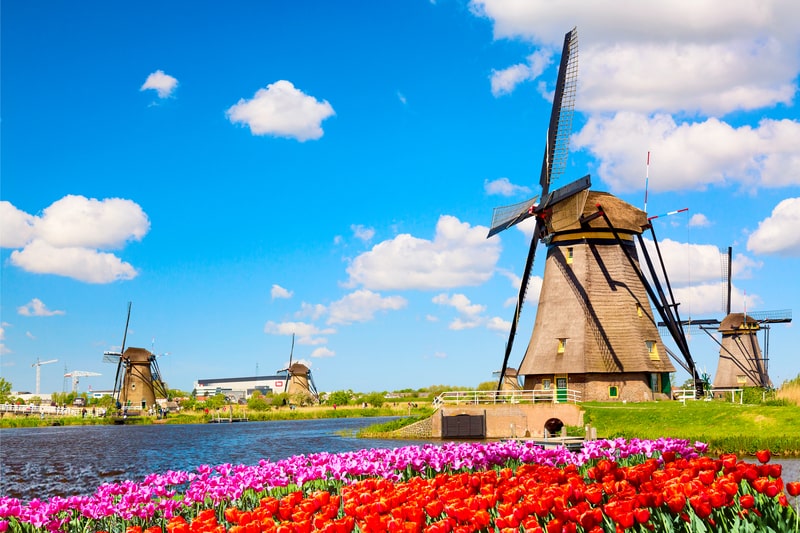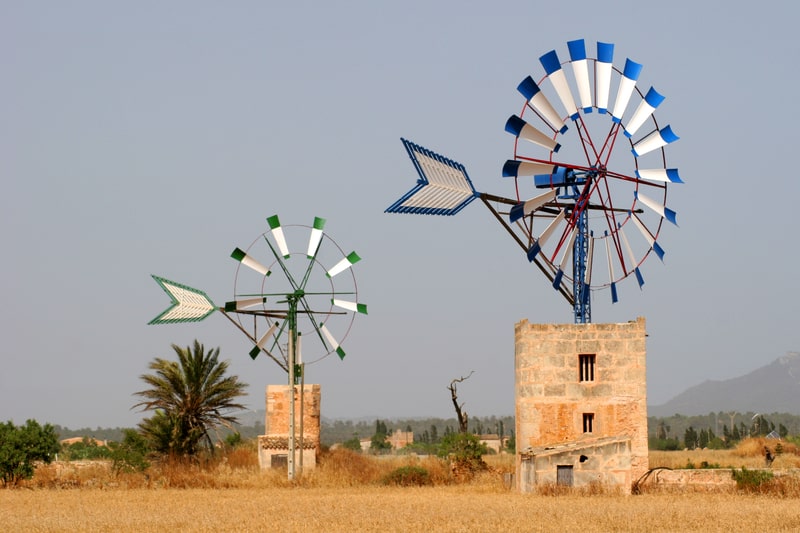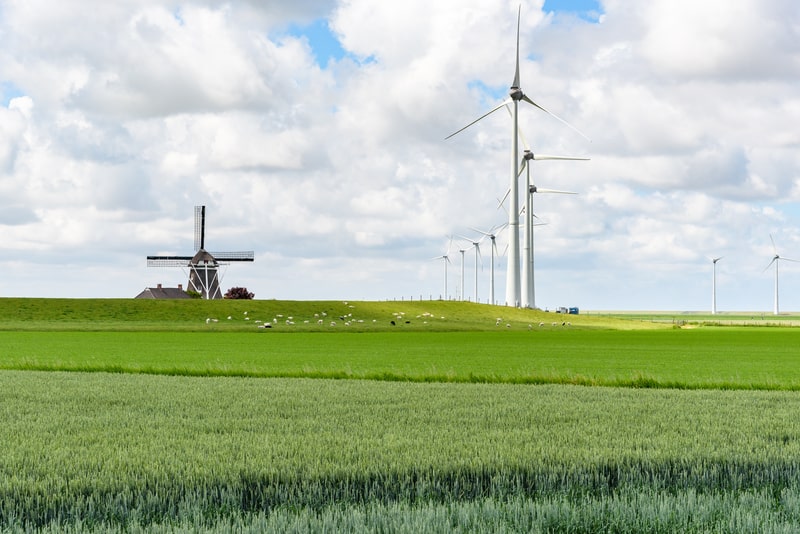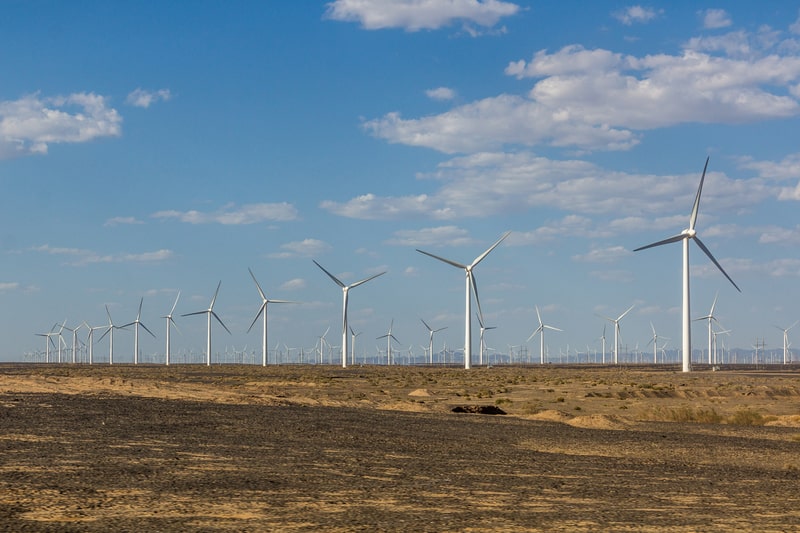Last updated on August 9th, 2023
Wind power is a renewable energy technology harnessing the natural force of wind to generate electricity. It involves using wind turbines consisting of large rotating blades attached to a central hub. As the wind blows, the blades spin, converting kinetic energy into electrical power through a generator. Merriam-Webster defines wind power as a sustainable method of energy production that utilizes the circular motion of wind-driven turbine blades to generate clean electricity. This eco-friendly solution presents numerous advantages, such as reducing greenhouse gas emissions and mitigating environmental impacts.
The History of Wind Energy
1. Wind energy has a rich history dating back to 5,000 B.C. when it was ingeniously utilized along the Nile to propel boats, marking one of the earliest recorded applications of this renewable resource.
2. In the 17th century B.C., the visionary Emperor Hammurabi of Babylonia had a groundbreaking idea to employ wind power for an irrigation project, showcasing early attempts at harnessing this clean and sustainable energy source for societal development.
3. Windmills, serving as ingenious machines, found various practical applications across different regions during ancient times, such as in the Middle East and Persia for grinding grain and in China around 200 B.C. for efficiently pumping water.

4. Advancements in wind technology during the 9th century led to the development of wind-powered machines in Iran, Afghanistan, and Pakistan, dedicated to milling cereals and facilitating water irrigation, showcasing the widespread adoption of wind energy solutions in various cultures.
5. The Dutch were instrumental in advancing wind power technology, as they pioneered large wind pumps around 1000 A.D., which played a crucial role in reclaiming land by draining lakes and marshes in the Rhine River Delta.
6. Wind energy continued its expansion across Europe, with the U.K. witnessing one of the earliest recorded windmills in Yorkshire, dating back to 1185, representing the growing importance of harnessing wind power for various applications.
7. In the early 17th century, European settlers in the Virginia Colony, USA, brought their knowledge and expertise, leading to the construction of the first windmill in 1621. This remarkable feat harnessed the power of the wind, enabling the windmill to grind grains, pump water, and perform essential tasks.
8. The late 19th century saw pioneering efforts in electricity generation using wind energy. Professor James Blyth created the first wind turbine for this purpose in 1887, laying the foundation for future innovations in renewable energy.

9. Building on Blyth’s work, Charles F. Brush constructed a larger wind turbine in Cleveland, Ohio, in 1888, which proved its effectiveness by charging batteries and powering lights, demonstrating early successes in utilizing wind power for practical applications.
10. In 1891, Danish innovator Poul la Cour made significant strides in wind turbine development, focusing on generating electricity and aiming to extend its benefits to rural areas, indicating a growing interest in providing electricity to remote communities through sustainable means.
11. In 1941, the world witnessed the construction of the first-ever megawatt-sized wind turbine, a groundbreaking innovation with a rated capacity of 1.25 megawatts, setting the stage for future developments in wind power technology.
12. From 1956 to 1966, the Station d’Etude de l’Energie du Vent in France operated an experimental 800 KVA wind turbine, marking early efforts to explore wind power at larger scales and laying the groundwork for future advancements in renewable energy.
13. During the 1970s, amid concerns over oil shortages and environmental issues, wind energy gained significant traction as an alternative source for electricity generation, sparking a transformative shift towards renewable energy solutions.

14. In 1978, a groundbreaking multi-megawatt wind turbine capable of delivering 2 megawatts of power was constructed, a significant achievement that paved the way for larger and more efficient turbines in the future.
15. The 1970s also marked a crucial period in the energy landscape, where governments worldwide, led by the United States and NASA, intensified their research and development efforts to promote wind energy as a clean and sustainable alternative.
16. The early 1980s witnessed a surge in wind turbine installations in the United States, fueled by forward-thinking federal and state policies to bolster renewable energy adoption and reduce dependence on fossil fuels.
17. Globally, wind energy witnessed an astounding surge, with at least 128 countries generating an impressive 1,808 billion kWh of wind electricity in 2021, reflecting the monumental strides made in embracing sustainable energy solutions.

18. In 2009, the pioneering Hywind Demo marked a historic moment as the world’s inaugural floating wind turbine installation.
19. Building on this success, Equinor achieved another groundbreaking milestone in 2017 with the launch of Hywind Scotland, the world’s first fully operational floating wind farm.
20. In 2022, wind energy sources made a significant contribution, comprising almost 7.33% of global electricity generation, demonstrating notable growth from the previous year’s 6.6% share.

21. Notably, this figure was more than double the proportion recorded in 2015, the year when the Paris Agreement was adopted, showcasing the remarkable progress and increasing prominence of wind power in the pursuit of sustainable energy solutions worldwide.
22. As of 2021, the world’s cumulative wind power capacity has reached an impressive 743 gigawatts (G.W.), a remarkable feat contributing significantly to mitigating environmental impact.
23. By harnessing this substantial wind energy capacity, over 1.1 billion tonnes of CO2 emissions are effectively avoided globally, making a significant and positive contribution towards combating climate change and promoting a greener future.
24. The evolution of wind turbine technology has been awe-inspiring, with today’s modern turbines generating over 10 megawatts, starkly contrasting the humble 12-kilowatt output of the first wind turbine built in 1887, exemplifying the tremendous progress made over the years.
25. In 2020, the wind energy industry attracted a record $138.2 billion in investments worldwide, signifying the increasing confidence in renewable energy sources and their potential to drive economic growth while addressing environmental challenges.
Wind Energy and the Environment
26. Wind energy saved 118 million tonnes of CO2 in Europe in 2019 and could save up to 270 million tonnes in 2030, equal to Spain’s annual CO2 emissions.
27. Operating wind turbines emit no greenhouse gasses or air pollutants, making them an environmentally friendly energy source.

28. Wind farms promote biodiversity and sustainable land and sea use, preserving habitats and ecosystems. The wind industry actively works to minimize environmental impacts through strategic planning and technology.
29. Wind turbines are cared for at the end of their operational lives, with 85 to 90% of their total mass recyclable. Efforts are made to make rotor blades fully recyclable.
30. WindEurope is committed to reusing, recycling, or recovering 100% of decommissioned wind turbine blades by 2025, aiming for a sustainable future.
Wind Energy in the Guinness Book of World Records
31. As of 2021, China has secured a remarkable position as the global leader in installed wind energy capacity, boasting 328 gigawatts (G.W.), as the International Renewable Energy Agency (IRENA) reported.
32. This remarkable achievement positions China with nearly three times the wind energy capacity of the second-highest country, the USA, highlighting its unparalleled commitment to renewable energy adoption.
33. Additionally, Germany, India, and Spain follow closely in the rankings, completing the top five countries with significant wind power contributions, showcasing the global momentum towards a more sustainable energy landscape.
34. In 2007, Germany demonstrated its commitment to renewable energy by significantly increasing its investment in the sector, reaching over $14 million (equivalent to £7 million).

35. The Jiuquan Wind Power Base, also known as the Gansu Wind Farm, located in the Gansu province, China, already achieved an impressive installed capacity of 5.36 gigawatts (G.W.) by 2012. With ambitious plans, it aimed to expand further and reach a remarkable capacity of 20 G.W. by 2020.
36. Spanning across vast desert landscapes, the facility’s separate arrays of turbines extend over 200 kilometers, forming part of an even grander vision to establish seven wind power facilities in the same area, each with a capacity of at least 10 G.W.
37. The region’s geographic and climatic conditions, particularly the deserts of Gansu, make it highly suitable for wind power generation, offering an average annual effective wind-power density exceeding 150 W/m² and an impressive duration of effective wind speed surpassing 6,000 hours per year.
38. The Gaildorf Pilot Project in Gaildorf, Germany, houses one of the tallest wind turbines worldwide, featuring four colossal Hybridturm (hybrid tower) turbines designed and constructed by German engineering firm Max Bögl AG.
39. Each of these impressive turbines boasts a towering hub height of 178 meters (584 feet) and is equipped with rotors extending to an impressive 246.5 meters (808 feet).
40. Commissioned and connected to the grid on 19th December 2017, these cutting-edge wind turbines stand as a testament to technological advancement and a significant step forward in harnessing wind energy at soaring heights.

41. The Smith-Putnam wind turbine, erected on Grandpa’s Knob in Vermont, USA, is the world’s first wind turbine to generate over 1 megawatt (M.W.) of electricity.
42. Designed by American engineer Palmer Cosslett Putnam, the turbine was inspired by the simple windmills used by isolated homesteaders in the Great Plains, employing innovative manufacturing techniques from the aviation industry and featuring two 66-ft (20-m) blades attached to a rotor hub soaring 120 ft (36 m) above the ground.
43. This groundbreaking turbine was synchronized with the local power grid on 19th October 1941, symbolizing a significant leap in wind power technology. However, it faced challenges during its operation due to wartime shortages, experiencing bearing failures and catastrophic blade incidents.
44. The General Electric Haliade-X, developed by G.E. Renewable Energy, is the most powerful wind turbine in operation, boasting an impressive generating capacity of 13 megawatts (M.W.).
45. The first prototype of the Haliade-X, initially designed with a power capacity of 12 M.W., underwent testing in the port of Rotterdam on 17th October 2019 and was subsequently upgraded to 13 M.W. after further assessments on 22nd October 2020.
46. This remarkable wind turbine features rotor blades measuring a staggering 107 meters (351 feet) in length, with a hub diameter of 6 meters (19 feet 8 inches). They are manufactured primarily in St Nazaire and Cherbourg, France, under G.E. Wind (Offshore).
47. In January 2020, the Haliade-X 13-MW prototype achieved a new milestone, setting a 24-hour power generation record with an impressive output of 288 MW/h in a single day. Its sheer size allows a single rotation of the rotor to produce enough electricity to power an average home for more than two days, exemplifying its efficiency and capability.

48. The Haliade-X’s outstanding performance led it to be selected for the prestigious Dogger Bank Wind Farm project, a massive collection of wind farms currently under construction in the middle of the North Sea. This project will be completed by installing 190 Haliade-X 13 M.W. turbines.
49. This will result in an impressive total generating capacity of 4.8 GW, further cementing the Haliade-X’s position as a leading solution in the renewable energy landscape.
50. On 15th May 2017, The LEGO Group, based in Denmark, accomplished a remarkable feat in Liverpool, UK, by constructing the largest LEGO® brick wind turbine, reaching an impressive height of 7.63 meters (25 feet 0.39 inches).
51. Hornsea 2, developed by Ørsted (DNK), stands as the largest offshore wind farm globally, situated in the North Sea approximately 89 kilometers (55 miles) off the coast of Yorkshire, U.K.

52. The facility declared fully operational on 31st August 2022, comprises an impressive array of 165 Siemens Gamesa 8-megawatt wind turbines, boasting a remarkable power-generating capacity of 1,320 gigawatts.
53. With the combination of the adjacent 1,218-megawatt Hornsea 1 wind farm (the previous record holder) and the under-construction 2,852-megawatt Hornsea 3 farm, this comprehensive development will soon be capable of supplying sufficient electricity to meet the needs of around six million homes.
54. In 2018, the United Kingdom emerged as the global leader in generating electricity from offshore wind power. With an impressive installed capacity of 8,216 megawatts (M.W.), the U.K. harnessed the potential of its offshore wind resources to produce a substantial 26,687 gigawatt-hours (GWh) of electricity throughout the year.
55. In 2018, China stood as the global frontrunner in generating electricity from wind power. Impressively, the country boasted an installed capacity of 184,665 megawatts (M.W.), harnessing the vast potential of wind resources to produce a remarkable 366,452 gigawatt-hours (GWh) of electricity annually.

Benefits of Wind Energy
56. Wind power creates over 120,000 jobs in the U.S., with wind turbine technicians ranking as the second-fastest-growing job of the decade.
57. Wind turbines generate around 10.3% of the U.S. energy, contributing $20 billion to the country’s economy in 2022.
58. Wind energy helps avoid 334 million metric tons of CO2 emissions annually, equivalent to taking 73 million cars off the roads.
59. Wind projects deliver around $1.9 billion in state and local tax and land-lease payments yearly.
60. Wind turbines require hundreds of tons of materials for permanent magnets, including steel, concrete, copper, and rare earth elements like neodymium and dysprosium.
61. Steel, aluminum, and epoxy resins contribute significantly to the carbon footprint of wind turbines, with the steel tower accounting for 30%, the concrete foundation 17%, and the carbon fiber and fiberglass blades 12%.
62. Wind power’s carbon footprint is 99% less than coal-fired power plants, 98% less than natural gas, and surprisingly 75% less than solar when amortizing the carbon cost over the equipment’s long lifespan.
63. The wind energy sector employs over 1.1 million people worldwide and is expected to create 3.3 million new jobs globally over the next five years.
64. Wind power is poised to cover 35% of global power needs and deliver one-quarter of the annual global CO2 emission reductions needed by 2050. It is a pivotal solution in the fight against climate change.

Wind Energy Across the World
65. Wind power has been soaring across the world since the turn of the millennium, with a whopping 2100 TWh of cumulative installed electricity generation capacity by the end of 2022.
66. Surprisingly, more than half of the new wind power capacity installed since 2010 can be found outside the traditional markets of Europe and North America. China and India have been at the forefront of this wind energy revolution.
67. China’s commitment to wind power is extraordinary, with a staggering 145 GW of wind power installed by the end of 2015. The same year, China was responsible for nearly half of the world’s added wind power capacity.
68. In Denmark, the total electricity from wind energy amounts to 16.08 TWh (terawatt-hours). This impressive contribution from wind power corresponds to 43.8% of the country’s total electricity consumption.
69. Lithuania, Uruguay, and Ireland are also impressive, with 40%, 36%, and 35% wind power penetration, respectively.
70. In 2022, the global wind capacity reached a total of 900 GW (gigawatts), with a significant proportion of 93% being attributed to onshore wind systems. The remaining 7% was derived from offshore wind farms.
71. It is worth noting that onshore wind technology is more established now, as it is actively utilized in 115 countries worldwide. On the other hand, offshore wind is still in the early stages of expansion, with its capacity currently present in only 20 countries.
72. The wind power boom is not just confined to China and Europe. Upcoming wind power markets have emerged in the Middle East, Latin America, South East Asia, and Africa, with their collective share rising from 8% to 10% in 2018.
73. In 2018, global wind power capacity witnessed a remarkable increase of 51 G.W., reaching a total of 591 GW, representing an incredible 9.6% growth from the previous year.
74. The top 10 countries with the most added wind capacity in 2021 include China, the United States, Germany, India, Spain, the United Kingdom, Brazil, France, Canada, and Sweden.

75. As of the end of 2022, Germany had a total installed capacity of 58,106 MW (megawatts) from onshore wind energy. This capacity was generated by a cumulative total of 28,443 onshore wind turbines nationwide. During 2022, Germany saw the addition of 551 new onshore wind turbines, with a combined capacity of 2,403 MW.
76. In 2022, wind turbines accounted for approximately 10.2% of the total electricity generation in the United States at the utility-scale level. “Utility-scale” refers to facilities with a minimum electricity generation capacity of one megawatt (1,000 kilowatts) or more.
77. Wind energy has experienced remarkable growth as India’s fastest-growing renewable energy source. Given the country’s extensive coastline, India has harnessed wind power through both onshore and offshore Wind Power Plants. As of 30th September 2022, the total installed wind energy capacity in India amounts to an impressive 41.666 gigawatts (G.W.).
78. As of 2022, Spain’s total installed renewable power capacity surpassed 69.5 GW. Among the various renewable sources, wind power stood out as the leading contributor, representing over 40% of the total renewable installed capacity with a capacity of 29.7 GW.
79. Brazil, an emerging renewable energy market, has made significant strides, boasting an impressive 24 G.W. of installed wind capacity.
80. Poland is quickly becoming a prominent player in offshore wind ambitions. The nation has set an ambitious target of awarding 10.9 gigawatts (G.W.) in capacity by 2030, with the first installations from the initial round scheduled to commence in 2026.
81. In 2022, more than 53% of Denmark’s total electricity consumption was provided by wind power. This marked a notable increase compared to the previous year, where wind power accounted for 43.7% of the electricity coverage.
. . . continue reading on the next page
